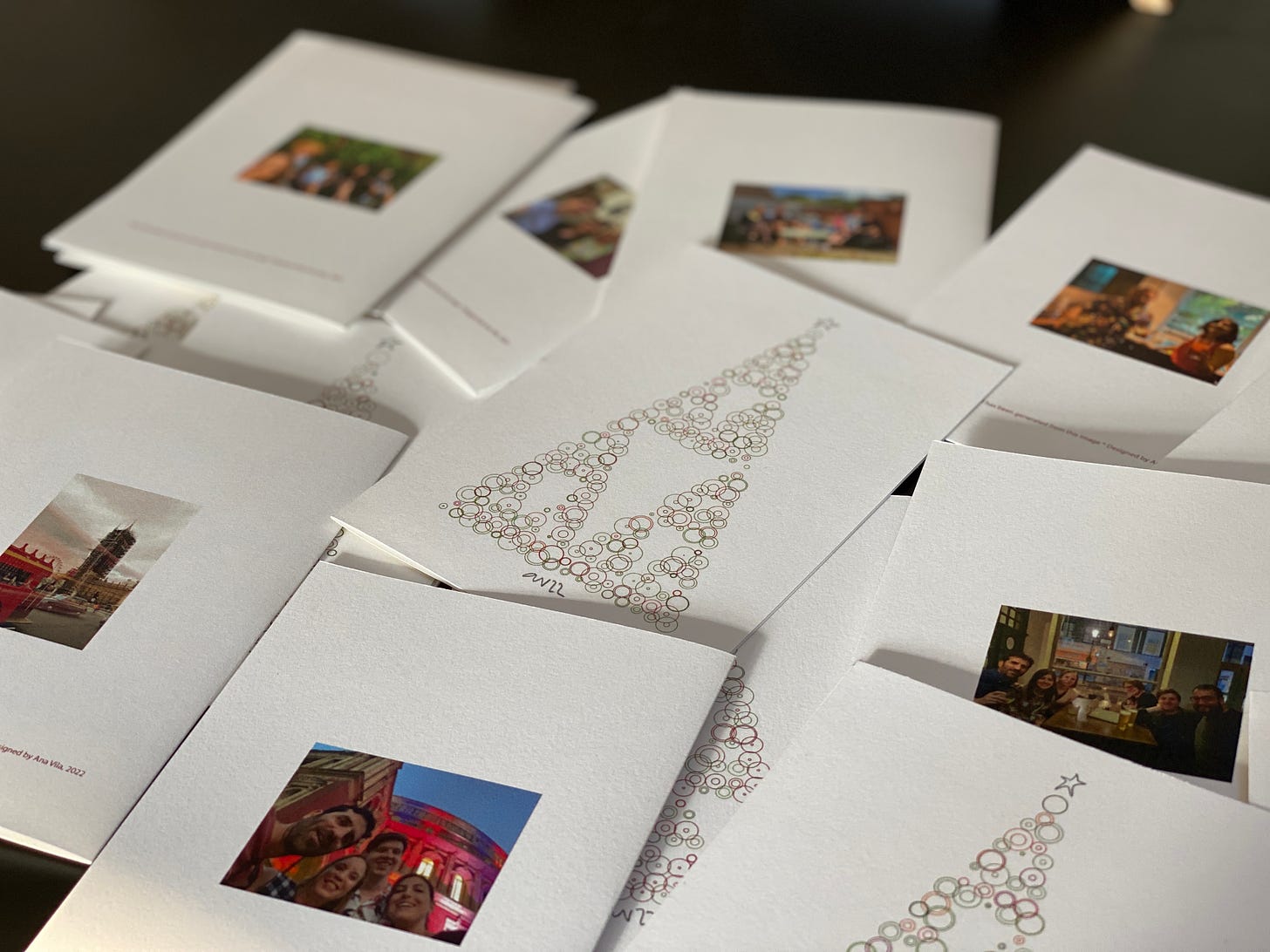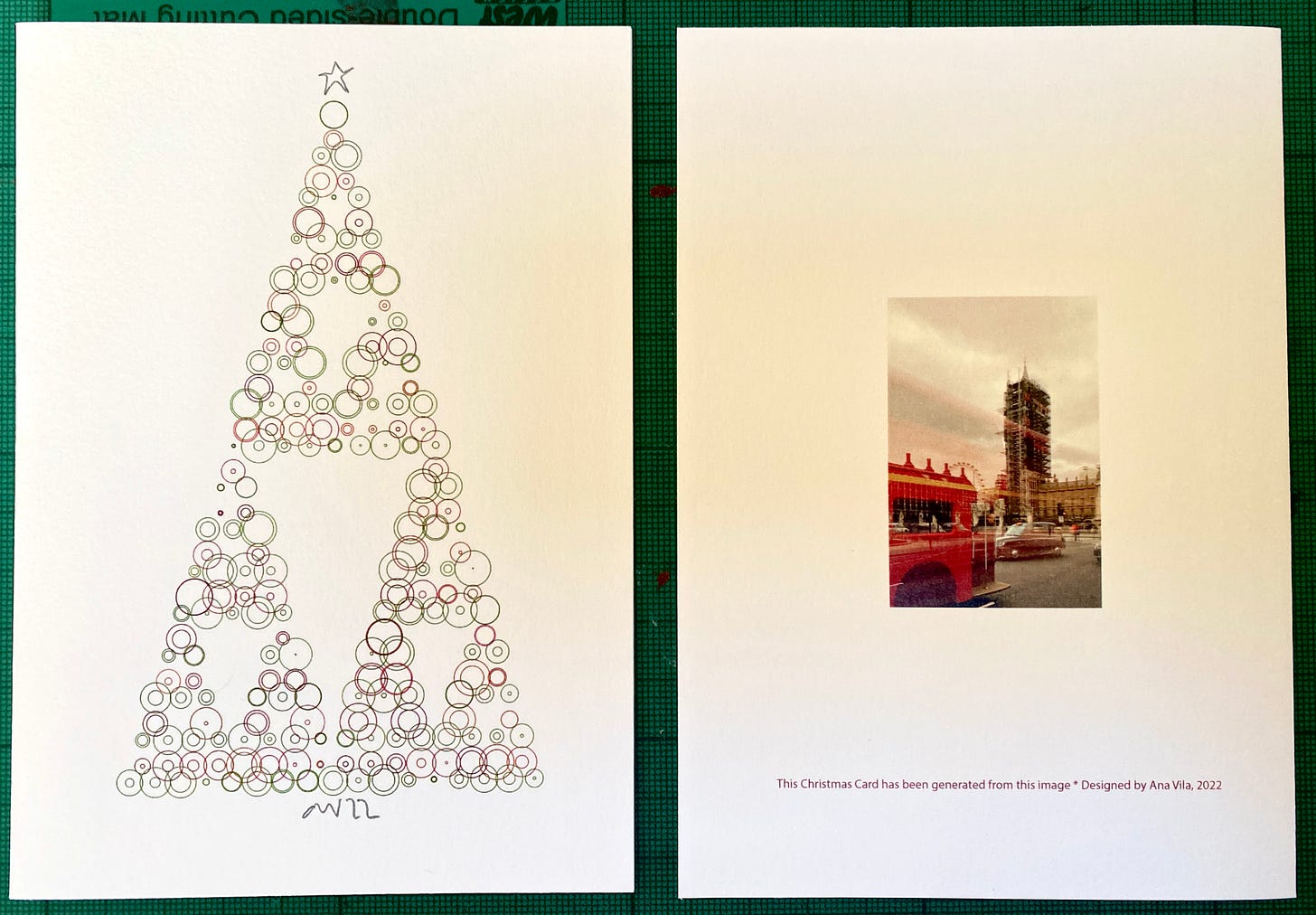‘I will honour Christmas in my heart, and try to keep it all the year. I will live in the Past, the Present, and the Future. The Spirits of all Three shall strive within me. I will not shut out the lessons that they teach!’ — A Christmas Carol, Charles Dickens
⭐️
Past
Every Christmas in London is special.
Some have been more special than others, and that usually has to do with the people around, but generally, Christmas is a lovely time to come to town: the lights, the cold, the cozy cafes, the Christmas vibes. (Some people would say it’s the worst time because of Oxford Street being unwalkable, and they are right, about the walkability, not the time, but worth a stroll along the Southbank instead on a dark late afternoon. And a stop on that bench from the film Love Actually overlooking the Thames and the City).
London has always been an inspiration to me. The Christmas of 2019, inspired by some of London landmarks (the Big Ben tower, the Shard, and the London Eye), I designed my first Christmas Card ever as an adult. Every year, ever since, I design a different Christmas Card I send to my dearest friends a family.
In this previous post I write a bit more about it:
🎄
Present
Designing the card this year was an absolute challenge: I decided to do a parametric and generative Christmas Card, therefore, I had to learn new software, another way of designing (thinking), and face a process I was not familiar with.
Although I am extremely happy with the result, there are some lessons learned and reflections when I look back on the design process:
Setting up design principles at the beginning kept me on track. Writing down my design rules helped me define a design framework in which to operate. A sort of design manifesto to come back to when in doubt or just after any step along the process. When I would conclude a working session with a particular outcome, I would go back to my design principles to test it against: is this the simplest way? Is it truly generative? Can I explore another approach? In this previous post, I write about the design principles I set up for this project:
The outcome did not matter in the end as much as the purpose or the why - the process was the real design. The Christmas Card could have been partly or entirely different, but the purpose of it being generative is what truly mattered. My idea was to design a script with certain design rules that will allow me to input an image that will generate different outputs within these constraints. That is what I was truly designing, the script, the process, not the end result.
Sometimes the best design is not necessarily the most iterated one, and that is okay - there is no waste in design, everything is a learning for the next project. The design that made it to the printer was not the last one I iterated, it was actually one I did two or three sessions before. Someone would say, ‘oh if you’d know, you’d saved yourself some hours of work!’. I would disagree. Never stop working. Keep iterating, and keep designing, even if you are happy with that idea. Test it. Ask questions. Divert. Everything is food for thought, ideas for the next project. Or better results yet to discover for the current one.
Creativity can be truly nurtured and encouraged. There was a moment when I had a turning point during the design process. This moment was possible because I thought creatively. I did not conform to the outcome and kept asking questions, forcing myself to see the design from a different perspective. Because the design was fundamentally parametric, I based the tree on a Sierpinski Triangle. I found the code online and did it, but that didn’t feel too exciting as a generative base and felt too rigid as a design. My train of thought shifted from focusing purely on the shape to seeing beyond the outcome, asking myself: what information can I extract from a triangle? And then, seeing beyond the pure triangular lines, I started focusing on what more was there: dots, vertices, grids of points. That opened up another set of possibilities and design explorations: I could use a grid of vertices and another grid of centres and apply different elements or polygons to each centre that will reveal a hint of the Sierpinski Triangle while allowing me to have more parametrical control.
I always have in mind this quote attributed to Einstein: ‘Insanity is doing the same thing over and over and expecting different results.’ When you want to obtain different results, look at things from a different point of view.
✨
Yet to Come
The most exciting thing about this project is not the result, which is nice and lovely, but the learning process that has started for me to think more parametrically and explore generative art and design in the next year.
One thing I know almost for certain: I won’t spend Christmas in London next year. But that is a story yet to come. In the meantime…
Merry Christmas
Feliz Navidad / Felices Fiestas
Bon Nadal / Bones Festes
✏️✨
And happy sketching!
Ana
Have you been drawing recently? It would be great to hear about it! Leave a comment and share your thoughts :)






